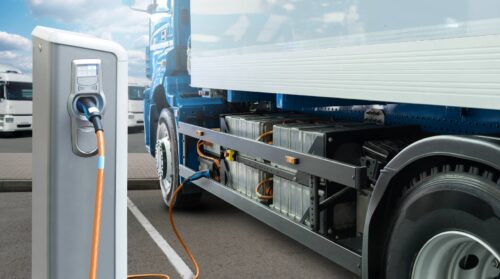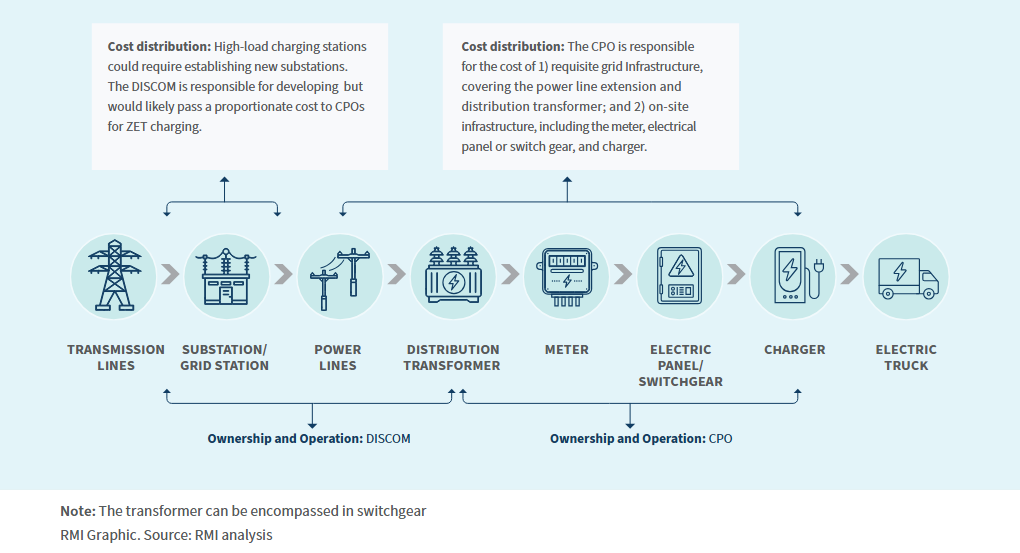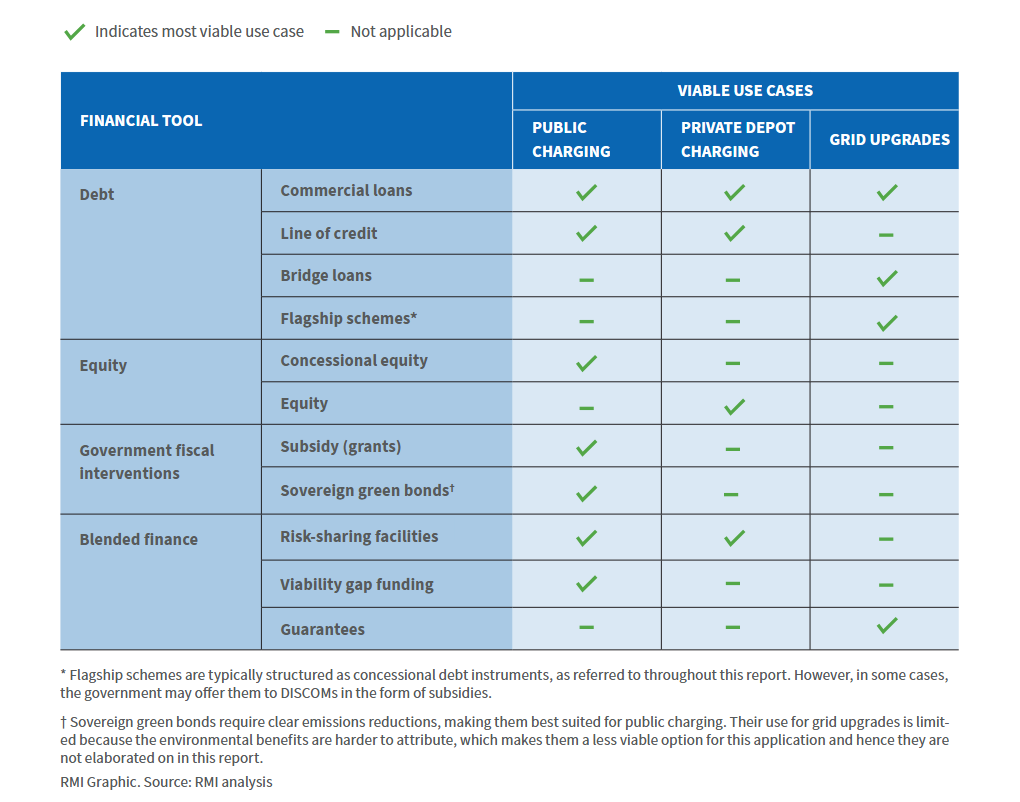
Funding Infrastructure to Put More Zero-Emission Trucks on India’s Roads
RMI’s latest report explores the financing needs, outlines solutions, and presents localized actions to get more zero-emission trucks on Indian roads.
India has a goal to be net zero by 2070. Meeting that goal means electrifying transportation, including transitioning to zero-emissions trucks (ZETs), which requires a reliable charging network and robust grid. Policy momentum is building, with ₹3.46 billion (US$39.8 million) in proposed subsidies for both bus and truck charging. However, to meet the scale and speed required for ZET adoption that aligns with India’s climate target, more financing is needed. To put the numbers in perspective, deploying 10,000 ZETs over the next three years would require an estimated investment of ₹11 billion (US$132 million) in charging infrastructure to ensure ZETs can travel reliably.
Despite growing government support and rising market demand, financing solutions for ZET infrastructure remain limited, largely due to investment risks perceived by financiers. These include unpredictable costs such as grid upgrades, land, and permitting, as well as uncertain revenues linked to infrastructure use and reliability. To address these challenges, RMI’s latest report, Financing Zero-Emission Trucking Infrastructure, offers an overview of the ZET infrastructure financing landscape and identifies viable pathways to unlock financing potential. This article summarizes the key takeaways from this recent study.
Financing needs
Charging infrastructure can be categorized into public and private charging. Public charging is usually located along highways and offers open access charging to any fleets. Private charging infrastructure is typically designed to serve the dedicated needs of specific fleet customers. The company that owns and/or operates and maintains public or private charging infrastructure is often called a charging point operator (CPO). CPOs can either be private companies operating on a commercial business model, or public entities including government agencies. CPOs and distribution companies (DISCOMs) coordinate to ensure sufficient and reliable power supply to support ZET charging. These two stakeholders are the primary borrowers involved in financing charging and grid infrastructure. The graphic below illustrates how CPOs and DISCOMs own and operate different components of the ZET charging value chain.
Cost Components and Ownership between DISCOMs and CPOs
Broadly speaking, DISCOMs are responsible for owning and operating front-of-the-meter grid infrastructure including substations and power lines, while CPOs invest in the chargers and on-site electrical equipment such as switchgear. However, in practice, the actual division of costs between DISCOMs and CPOs can vary from project to project, depending on the specific terms of their agreement. For example, a DISCOM may own and operate the transformer, but the associated costs could be shared with the CPO.
In addition to the costs outlined in the table, there are other important expenses to consider, such as land costs and soft costs including permitting, engineering, and other administrative expenses. Understanding the business structure and cost responsibilities of both DISCOMs and CPOs is crucial for financiers to make informed and strategic investment decisions.
Available solutions
Different financing solutions will be required for public charging, private depot charging, and grid upgrades, as summarized in the table below.
Financial Tools and their ability to finance public charging, private depot charging, and requisite grid upgrades
The table outlines structured tools for financing ZET charging, including debt, equity, government fiscal interventions, and blended finance approaches. To turn these theoretical concepts into action, stakeholders need to develop practical delivery pathways that lead to successful outcomes. Public charging, private charging, and grid upgrades each require different implementation models for effective financing.
Public charging
For public charging, public-private partnerships (PPPs) are essential to kickstart the market. Public charging stations, being quasi-public goods accessible to multiple fleets, face uncertain demand and low utilization in a nascent market. Stakeholder interviews indicate that public charging stations in ZET pilots in India frequently operate at utilization rates below 10 percent.
What does this number mean for charging price? Assuming a project with ten 500 kW chargers, a starting utilization rate of 7 percent, and a 3 percent annual increase, the CPO would need to price electricity at ₹23/kWh (US$0.26/kWh) to achieve a 15 percent internal rate of return (the standard benchmark for infrastructure projects to achieve economic viability) over a 15-year period. However, at this tariff, the total cost of ownership for a ZET would be approximately 27 percent higher than that of a comparable diesel truck.
In the face of such early market challenges, particularly low infrastructure utilization, PPPs can help mitigate risks and encourage greater private sector investment. This, in turn, can create a positive feedback loop that enhances infrastructure usage and improves the long-term viability of the business model.
In a PPP model, the public sector is well positioned to provide land, grants, and concessional financing, while the private sector contributes technical expertise and innovation. Various PPP structures exist, with different allocations of responsibility between public and private partners across financing, design, construction, operation, and ownership.
Private depot charging
An effective business model for private depot charging is charging-as-a-service (CaaS), which offers multiple co-benefits for fleets, CPOs, and financiers. For fleets, CaaS shifts the responsibility of developing and operating charging infrastructure to CPOs, who are specialized players better equipped to manage risks and day-to-day operations. This model shifts the capital burden of charging infrastructure investments from fleets to CPOs, allowing fleets to manage more predictable operating costs. For CPOs, the model creates opportunities to improve asset utilization and maximize revenue. Overall, more predictable cost and revenue streams enhance project bankability and attract more private financing.
Grid upgrades
Proactive, early-stage planning and coordination among fleets, CPOs, DISCOMs, and local regulators is essential to implement effective financing solutions for grid upgrades. Fleets and CPOs can collaborate with DISCOMs to identify suitable charging locations and share demand forecasts, while DISCOMs can streamline connection processes to reduce soft costs and prevent administrative delays. Local governments play a key role in providing clarity on land use, siting, and grid connection procedures. Together, these efforts ensure reliable power supply during ZET charging operations, creating enabling conditions needed to effectively boost financier confidence and deploy financing tools.
Recommended actions
Leveraging the financial solutions outlined above requires coordinated efforts among key stakeholder groups, including central and state governments, development finance institutions, non-banking financial companies (NBFCs), and banks, all of which play a role in providing capital.
Creating a positive feedback loop to grow zero-emission trucking
ZET and charging infrastructure deployment is often described as a chicken-and-egg dilemma: fleet operators wait for charging infrastructure before committing to trucks, while charging point operators delay investment without confirmed demand. Breaking this cycle requires coordinated progress on both fronts to create a positive feedback loop. Financing Zero-Emission Trucking Infrastructure outlines financing solutions that can help de-risk investments, jumpstart infrastructure development, and scale the ZET charging market. In turn, these solutions can support wider ZET adoption, improve charger utilization, enhance project viability, and accelerate the overall growth of zero-emission trucking in India.

